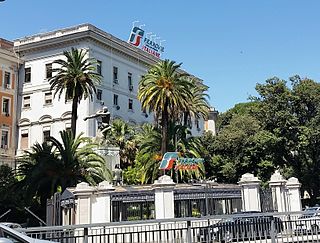
Trenitalia is the primary train operator in Italy. A subsidiary of Ferrovie dello Stato Italiane, itself partly owned by the Italian government, the company and partly from private investors group. It was established in 2000 following a European Union directive on the deregulation of rail transport.
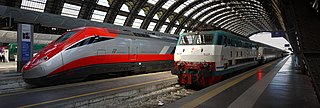
The Italian railway system is one of the most important parts of the infrastructure of Italy, with a total length of 24,227 km (15,054 mi) of which active lines are 16,723 km. The network has recently grown with the construction of the new high-speed rail network. Italy is a member of the International Union of Railways (UIC). The UIC Country Code for Italy is 83.
Hitachi Rail Italy S.p.A. is a multinational rolling stock manufacturer company based in Pistoia, Italy. Formerly AnsaldoBreda S.p.A., a subsidiary of state-owned Finmeccanica, the company was sold in 2015 to Hitachi Rail of Japan. After the deal was finalized, the current name was adapted in November 2015 to reflect the new ownership.
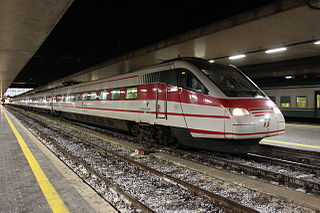
Eurostar Italia was the name given to high-speed trains operated by Trenitalia in Italy. The brand was discontinued and replaced with Le Frecce in December 2012.

ETR 450 was the first series Italian tilting train.

The Italian railway system is one of the most important parts of the infrastructure of Italy, with a total length of 24,227 km (15,054 mi) as of 2011.
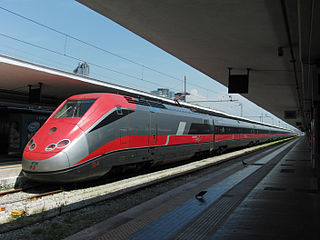
High-speed rail in Italy consists of two lines connecting most of the country's major cities. The first line connects Turin to Salerno via Milan, Bologna, Florence, Rome and Naples, the second runs from Turin to Venice via Milan and Verona, and is under construction in parts. Trains are operated with a top speed of 300 km/h (190 mph).

ETR 470 is a high-speed tilting electric multiple unit, which is now only operated by the Greek company, Hellenic Train. Introduced in September 1996, nine units were built for the Italo-Swiss firm Cisalpino. They were made by Fiat Ferroviaria, and could tilt up to 8°. Today, there are five trains in Greece.

Nuovo Trasporto Viaggiatori S.p.A. is an Italian open-access train operating company operating in the field of high-speed rail transport under the brand name Italo, stylized as .italo,.

The ETR 300, also known as "Settebello-type" for its use on the former Settebello train service, is a type of Italian fast electric multiple unit (EMU) trainset formerly operated by Ferrovie dello Stato. The letters ETR stood for elettrotreno rapido. Thanks to its aerodynamically low-drag profile, it boasted a maximum speed of 200 km/h (124 mph), with a power output of 2600 kW. Manufactured for FS by Breda, a total of only three trainsets were built, numbered ETR 301–303.

The Milan–Bologna high-speed railway is a railway line that links the cities of Milan and Bologna, part of the Italian high-speed rail network. It runs parallel to the historical north–south railway between Milan and Bologna, which itself follows the ancient Roman Road, the Via Aemilia. The new railway follows the Autostrada A1 closely for much of its length. The new line allows faster traffic to run separated and increase the overall railway capacity between the two cities.

The FS E.326 was a class of Italian railways electric locomotives. Designed in 1929, they were introduced in the early 1930s, for hauling light express passenger trains at high speeds.

The ETR 460 is an electric multiple unit (EMU) tilting train produced by FIAT Ferroviaria since 1993. It is also known as the Pendolino after the family of trains from which it comes.
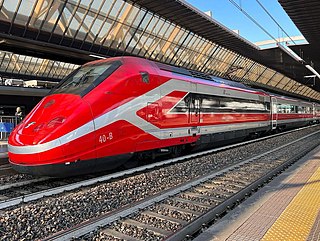
ETR 500 is a family of Italian high-speed trains built by AnsaldoBreda and introduced in 1993.
The ETR 240 is an Italian electric multiple unit (EMU) introduced in the 1980s.

The Frecciarossa 1000, is a high-speed train operated by Italian state railway operator Trenitalia and the private Spanish high-speed rail operator Iryo. It was co-developed as a joint venture between Italian rail manufacturer Hitachi Rail Italy and multinational conglomerate Alstom. Both design and production work were divided between the two partner companies.

The Settebello was a famous Italian high-speed express train that linked Milano Centrale in Milan with Roma Termini station in Rome, via Bologna and Florence. Introduced in 1953, it was operated by the Italian State Railways (FS) and used the distinctive ETR 300-type electric multiple unit trainsets, featuring observation lounges at the front and rear of the train. When introduced, it "set a standard of speed and luxurious travelling accommodation previously unknown in Italy [and] rivalling anything else on European rails." It was a Trans Europ Express (TEE) from 1974 until its withdrawal, in 1984.

The Vesuvio was an express train in Italy, linking Milan and Naples. The train was named after Mount Vesuvius the volcano near Naples.

Frecciabianca is a high-speed train of the Italian national train operator, Trenitalia, and one of its Le Frecce brands. The name, which means "white arrow", was introduced in 2011; these services were previously known as Eurostar City Italia. Frecciabianca trains operate at speeds up to 200 km/h (124 mph).

The Livraga derailment is the only railway accident to date on the Italian high speed rail network. It took place on 6 February 2020 when a high-speed train derailed at Livraga, Lombardy, Italy. Two people died and 31 were injured.

















